Perfect Pan-Seared Cast Iron Salmon: Crispy Skin, Lemon, and Dill
Prepare to elevate your weeknight dinners with this incredibly easy and delicious cast iron salmon recipe. In less than 15 minutes, you’ll create a restaurant-quality dish featuring succulent salmon, infused with bright lemon and fragrant dill, all basted in rich butter. The secret? A perfectly preheated cast iron pan that delivers irresistibly crispy skin and fish that is beautifully moist and tender on the inside. This isn’t just a recipe; it’s your new go-to for quick, healthy, and exceptionally flavorful seafood.
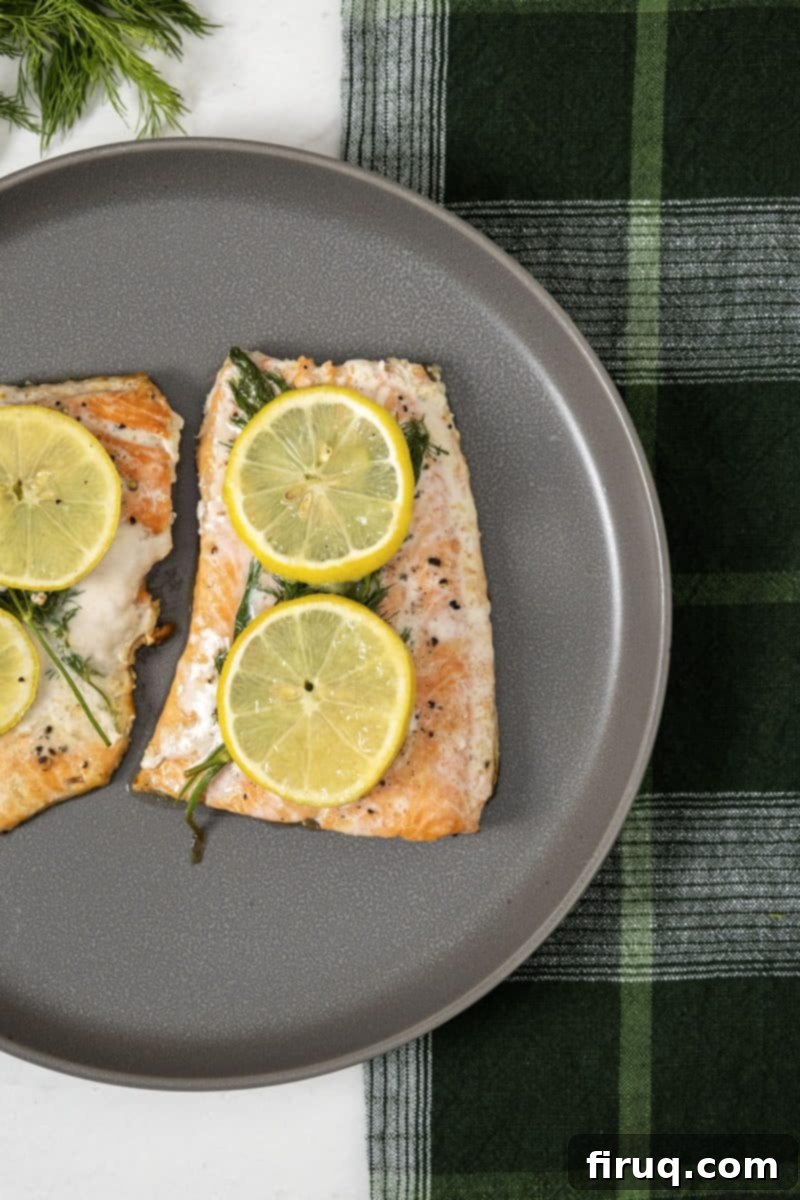
If you enjoy seafood and are looking for more delicious options, you may also enjoy these fantastic recipes: Pistachio Crusted Fish or Lemon Garlic Broiled Flounder. These offer distinct flavors and textures, perfect for expanding your seafood repertoire.
Why This Cast Iron Salmon Recipe Works Wonders
Salmon, for all its deliciousness and health benefits, can sometimes be a bit of a challenge to cook perfectly. Many home cooks experience the dilemma: too moist and it feels undercooked, too dry and it loses its luxurious texture. When I first started cooking salmon, it was often hit or miss. The skin would remain flabby, refusing to crisp up, and the fish itself would absorb little to no flavor.
This particular cast iron salmon recipe is designed to eliminate those frustrations, consistently delivering fish with the crispiest skin and a beautifully moist, flaky flesh. The secret lies in a few key elements that work in harmony:
- The Cast Iron Pan: This isn’t just any pan; it’s a game-changer. Cast iron excels at retaining and distributing heat evenly, which is absolutely crucial for achieving that coveted golden-brown, crispy skin. The intense, consistent heat creates a perfect sear, locking in moisture and flavor.
- Proper Moisture Management (Especially for Frozen Salmon): Seafood, particularly when frozen and thawed, retains a significant amount of water. Without thoroughly removing this excess moisture, you’re essentially steaming the fish rather than searing it. This recipe emphasizes a simple, yet vital, step to pat the salmon dry, ensuring a proper sear and an incredibly crispy skin.
- The Instant-Read Thermometer: Salmon cooks rapidly, and even a minute too long can turn it from tender to tough. An instant-read thermometer is your best friend here. It takes the guesswork out of cooking, allowing you to hit that perfect internal temperature for optimal flavor and texture every single time, whether you prefer medium-rare or fully cooked.
By focusing on these three critical components, this recipe guarantees a flavorful salmon that is basted in a delectable lemon, dill, and garlic-infused butter, making it truly exceptional.
Essential Ingredients and Smart Substitutions
Crafting the perfect cast iron salmon starts with quality ingredients. Here’s what you’ll need and how you can adapt the recipe to your pantry or preference:
- Wild Atlantic Salmon (¾ – 1 lb): Whether fresh or frozen, aim for high-quality salmon. Wild-caught sockeye is a popular choice for its rich flavor and vibrant color, often available frozen year-round. If opting for fresh, prime season runs from spring through summer. For the best sear, ensure your salmon fillets are roughly uniform in thickness.
- Lemon (1 full lemon, 4 slices, and one half): Lemon is a non-negotiable component, providing a bright, acidic counterpoint to the richness of the salmon and butter. It also helps to tenderize the fish slightly. You’ll use slices for infusing flavor during searing and a fresh half for a final squeeze of juice, elevating the dish’s freshness.
- Butter (2 tablespoons): Unsalted butter is ideal for basting, adding a luxurious richness and helping to develop that beautiful golden crust. It’s crucial for the depth of flavor in this recipe.
- Garlic (1 crushed clove): A single crushed garlic clove infuses the basting butter with a subtle, aromatic warmth that complements the lemon and dill without overpowering the salmon. Fresh garlic is always best.
- Dill (1 bunch): The fresh, aromatic notes of dill are a classic pairing with salmon and lemon, creating a harmonious and refreshing flavor profile. I absolutely adore this combination!
- Avocado Oil (1 tablespoon): I strongly recommend avocado oil for searing salmon. It has a very high smoke point, meaning it can withstand the high heat needed for a crispy sear without burning or imparting off-flavors. Its neutral taste allows the salmon’s natural flavor and the lemon-dill notes to shine.
- Salt and Pepper: Simple, yet essential. Coarse sea salt and freshly ground black pepper are all you need to properly season the salmon, enhancing its natural taste.
Substitution Ideas:
- Herbs: While dill is fantastic, you can certainly experiment with other fresh herbs. Thyme offers an earthy, slightly citrusy aroma, while fresh rosemary provides a more robust, piney note. Both would create a different, but equally delicious, experience.
- Citrus: If you’re feeling adventurous or don’t have lemons, lime can be a suitable substitute, especially if using herbs like cilantro or a touch of chili for a different flavor profile. The acidity will still provide the desired brightness.
- Oil: If avocado oil isn’t available, a neutral-flavored, high-smoke-point oil like grapeseed oil or canola oil would work. Extra virgin olive oil has a lower smoke point and a more distinct flavor, which might not be ideal for achieving the crispiest skin at high heat, but it can be used if it’s all you have.
Step-by-Step Directions to Perfect Cast Iron Salmon
Achieving perfectly cooked salmon with crispy skin and a tender interior is simpler than you think. Follow these detailed steps for guaranteed success.
Wild Atlantic salmon is primarily available fresh from spring through summer. However, for year-round enjoyment, I often rely on wild-caught sockeye salmon, which is typically sold frozen. It’s important to note that frozen salmon, while convenient, retains a lot of water. If not addressed, this excess moisture can lead to soggy skin and a less than ideal sear. This is why proper preparation is key!
Step 1: Prepare and Season the Salmon
If using frozen salmon, ensure it is completely thawed. Rinse the salmon fillets under cold water to remove any ice crystals or residue, then pat them thoroughly dry with paper towels. Press firmly but gently on both sides to extract as much liquid as possible. This critical step ensures a crispy skin later on. Season both sides of your salmon fillets generously with salt and pepper. The fresh lemon and dill will add plenty of flavor during cooking, so simple seasoning is best here.
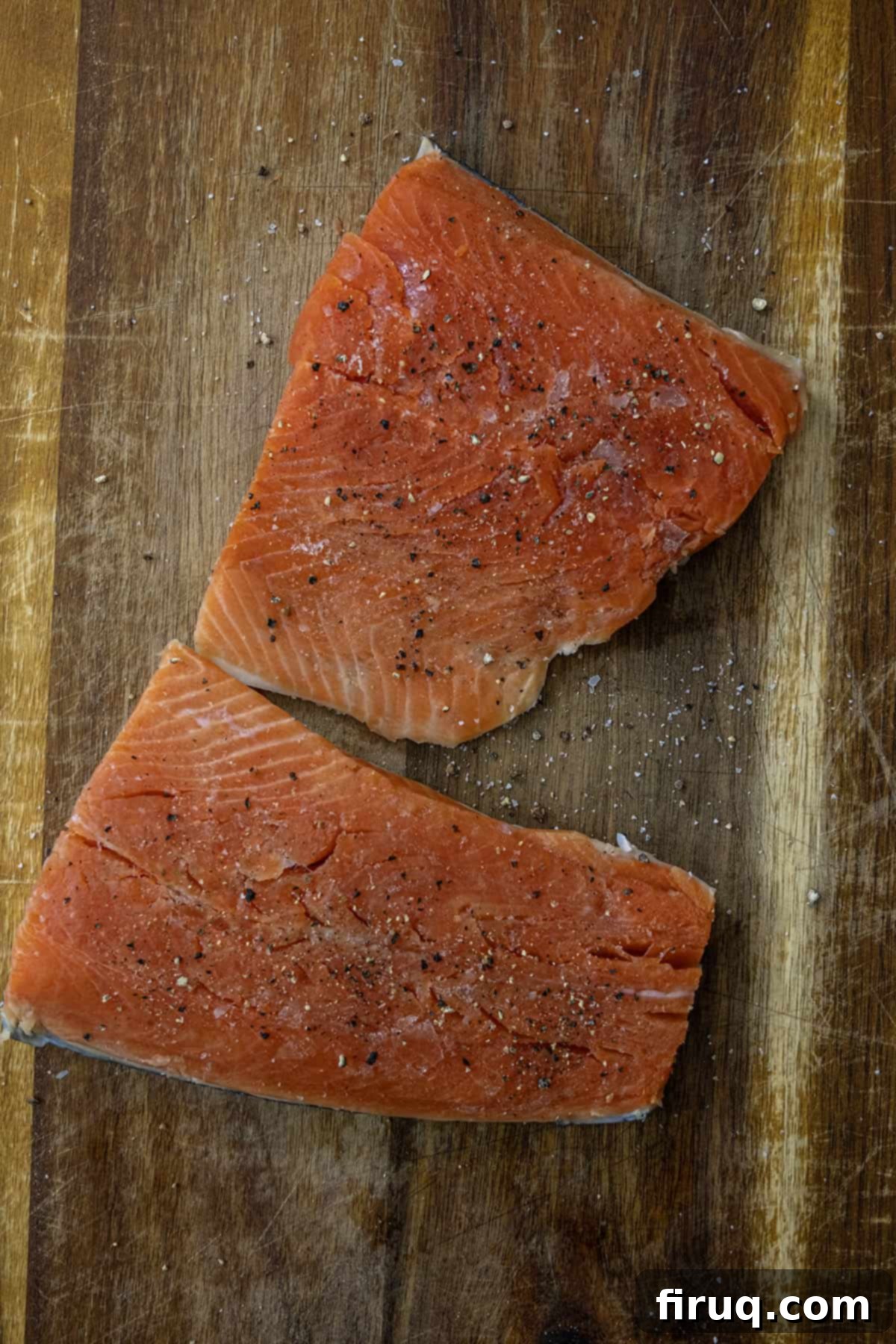
Step 2: Preheat Your Oven
Preheat your oven to 375°F (190°C). This ensures the oven is ready for the salmon to finish cooking, providing even heat and precise temperature control.
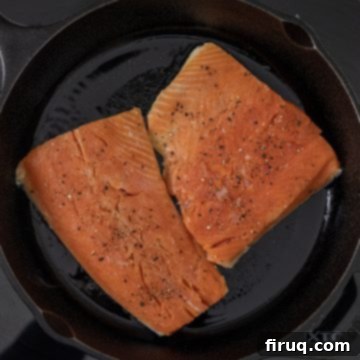
Step 3: Sear the Salmon
Place your cast iron pan on a burner and heat it over medium-high heat. Allow the pan to get very hot – a good indicator is when a drop of water sizzles and evaporates immediately. Once hot, add the avocado oil. When the avocado oil is shimmering (just before it smokes), carefully add the salmon to the pan, skin side down. This crucial step ensures the skin gets perfectly crispy. Avoid overcrowding the pan; cook in batches if necessary.
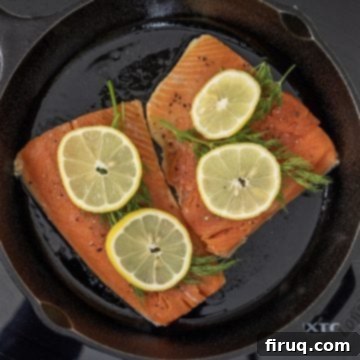
Step 4: Flavor Infusion and Initial Sear
While the salmon is searing skin-side down, arrange the dill sprigs and lemon slices on top of the salmon fillets. Place the remaining lemon half directly into the pan as well. Sear for 2-3 minutes, resisting the urge to move the fish. To check if the skin is crispy, carefully lift an edge with a spatula. The salmon should easily release from the cast iron when the skin has achieved a golden-brown crispness.
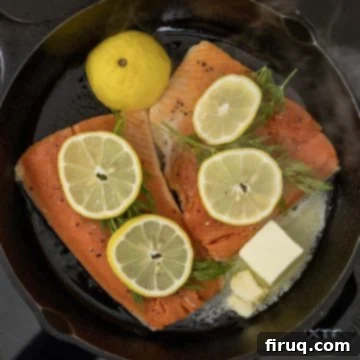
Step 5: Baste with Butter and Garlic
Reduce the heat slightly if needed. Add the butter to the pan along with the 1 crushed garlic clove. As the butter melts and sizzles, use a spoon to continuously baste the salmon. Spoon the melted butter and garlic mixture over the top of the fillets. Continue basting for about 1 minute, until the butter is almost completely absorbed and the salmon is glistening. This step infuses incredible flavor and ensures the fish stays wonderfully moist.
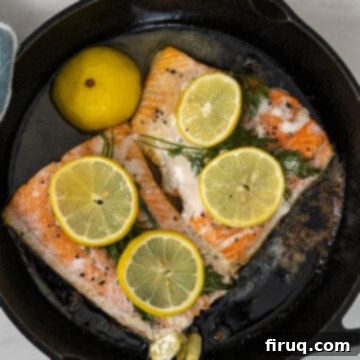
Step 6: Finish in the Oven
Carefully transfer the entire cast iron pan to the preheated oven. Bake for another 3-7 minutes. Salmon cooks quickly, so begin checking the internal temperature after 3 minutes using your instant-read thermometer. Precision is key here!
For a beautiful medium-rare finish, remove the salmon from the pan as soon as it reaches 120°F (49°C). Remember that the temperature will continue to rise slightly (carryover cooking) even after it’s out of the oven. If you prefer your salmon fully cooked or well-done, allow that temperature to reach 145°F (63°C).
Using an instant-read thermometer is absolutely crucial when cooking seafood. I advocate for never cooking without it because it guarantees your salmon is cooked to the exact desired temperature, ensuring optimal flavor, texture, and food safety.
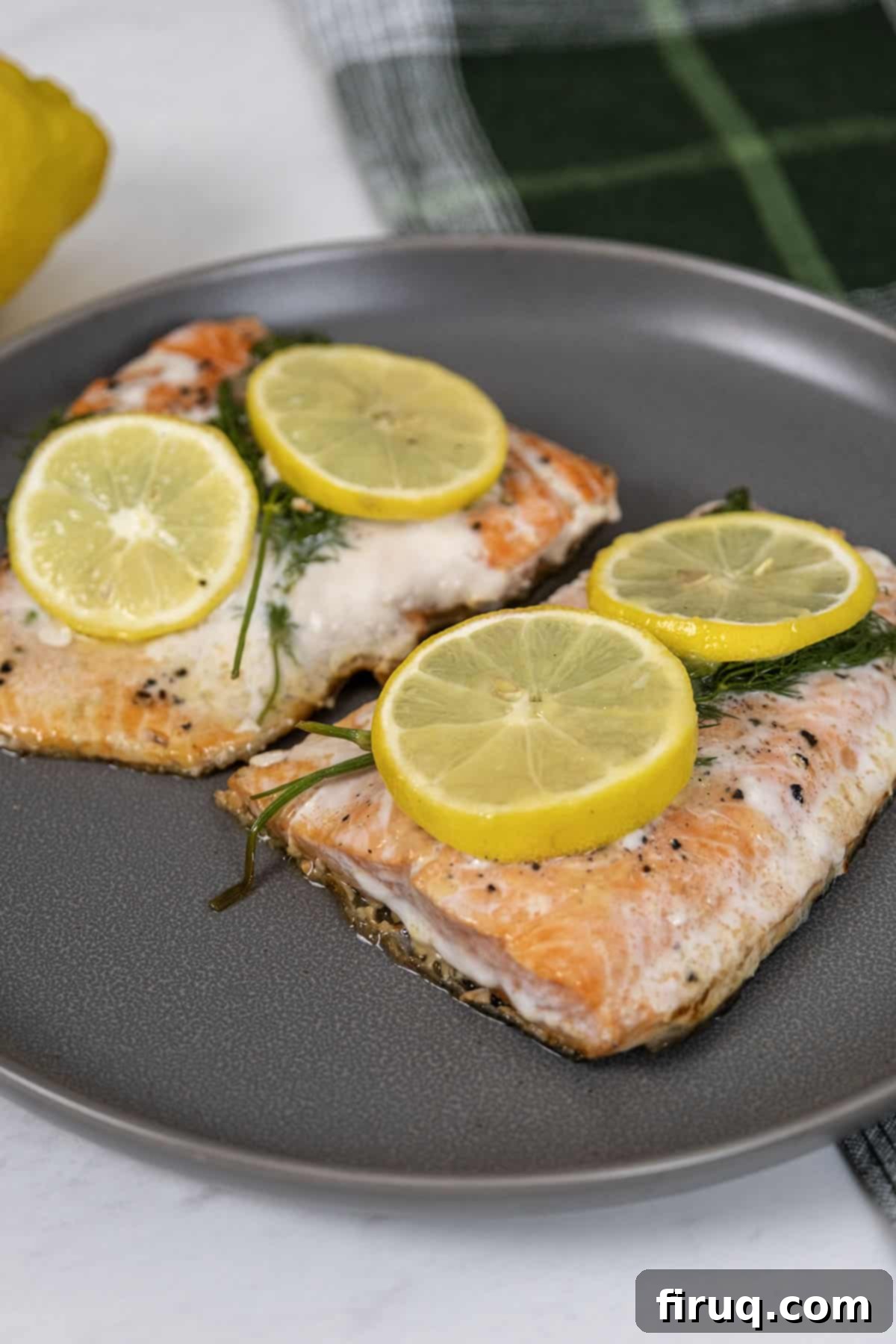
The finished salmon will be buttery and meaty, showcasing a light pink hue on the outside and a slightly darker pink on the inside (for medium-rare). Before serving, remove the lemon slices and dill sprigs. A final squeeze from the lemon half you put in the pan will add a burst of fresh flavor.
Pro-Tips for the Best Cast Iron Salmon
- Thoroughly Dry Your Salmon: This is arguably the most important step for crispy skin. Rinse the salmon to remove any ice crystals (if frozen) or residue. Then, use several layers of paper towel to apply firm pressure to both sides of the salmon, without pushing too hard, to remove as much liquid as possible. Repeat this until the salmon feels dry to the touch.
- Understand the “Why” of Drying: Removing excess water from frozen salmon (or even fresh salmon) is crucial because it allows the fish to cook evenly and ensures that it truly sears. Without this step, the moisture will heat up and essentially steam the fish, preventing the skin from becoming crispy and potentially leading to a less flavorful result.
- Don’t Overcrowd the Pan: If cooking multiple fillets, do so in batches. Overcrowding the cast iron pan will lower the pan’s temperature, leading to steaming instead of searing, and preventing that desired crispy skin.
- Use High-Quality Salmon: While the technique is key, starting with good quality salmon makes a noticeable difference in flavor and texture. Look for bright, firm flesh and a fresh, mild smell.
- Rest Your Fish: Just like steak, salmon benefits from a brief rest (2-3 minutes) after cooking. This allows the juices to redistribute, resulting in a more tender and moist fillet.
- Preheat Your Cast Iron Properly: A truly hot cast iron pan is essential. Don’t rush this step. Allow it to heat for several minutes over medium-high heat until it’s shimmering with oil or a drop of water quickly evaporates.
What to Serve with Your Cast Iron Salmon
This lemon dill salmon is incredibly versatile and pairs wonderfully with a variety of side dishes. My personal favorite accompaniment is a simple combination of fluffy rice and tender-crisp asparagus. The mild flavors perfectly complement the richness of the salmon.
However, if you’re looking to mix things up, consider these delicious options:
Vegetable Sides:
- Lacinato Kale: Sautéed or roasted Lacinato kale offers an earthy, slightly bitter counterpoint that balances the salmon’s richness.
- Italian Green Bean Salad: A refreshing and zesty salad that adds a light, crisp texture.
- Italian Cabbage: Braised or sautéed cabbage can provide a hearty, yet healthy, side that absorbs flavors beautifully.
- Roasted Broccoli or Brussels Sprouts: Simple roasted vegetables with a touch of olive oil, salt, and pepper are always a winning combination.
- Garden Salad: A fresh, crisp green salad with a light vinaigrette is perfect for a lighter meal.
Starchy Sides:
- Lemon Spinach Orzo: This creamy, lemony pasta dish is a perfect match, echoing the citrus notes in the salmon.
- Pastina Carbonara: For a comforting and rich side, a small portion of this creamy pasta would be delightful.
- Roasted Potatoes or Sweet Potatoes: Simple, satisfying, and easy to prepare alongside your salmon.
- Quinoa or Couscous: Healthy and light alternatives to rice, absorbing flavors well.
And if it’s the summer, I’ll often opt for a chilled and vibrant Italian Pasta Salad for a refreshing meal.
Recipe FAQs: Your Cast Iron Salmon Questions Answered
Absolutely, and it’s highly recommended! Some people hesitate to use cast iron for seafood, fearing it might leave a lingering fishy taste in the pan (like “The North, Cast-Iron remembers” – a little Game of Thrones humor!). While cast iron does absorb and retain flavors over time, this doesn’t mean everything you cook in it afterward will taste like fish. The high heat and excellent heat retention of cast iron are perfect for achieving a beautiful, crispy salmon skin and an evenly cooked fillet. After cooking, a proper cleaning and re-seasoning will ensure your pan is ready for its next meal without noticeable flavor transfer.
Yes, you absolutely can and it’s a great technique if you prefer a different texture. To sear both sides: Start by searing the flesh side (the side without skin) for about 2 minutes to get a nice golden crust. Then, flip the salmon over to the skin side, add your lemon and dill, and sear for another 2-3 minutes until the skin is crispy. After this, you can proceed with the basting and oven-finishing steps as outlined in the main recipe. This approach gives you a seared crust on both sides while ensuring the skin is still crispy.
While an instant-read thermometer is highly recommended for precision, you can estimate doneness. For medium-rare, the salmon will be slightly translucent in the center and flake easily with a fork on the edges. For well-done, it will be opaque throughout and flake completely. However, without a thermometer, there’s a higher risk of overcooking, which can lead to dry salmon. Investing in an inexpensive thermometer is highly recommended for best results with all proteins.
Allow any leftover salmon to cool completely. Store it in an airtight container in the refrigerator for up to 2-3 days. Reheat gently in a microwave on low power, or in a pan over low heat, to prevent drying it out. Leftover salmon is also delicious cold in salads or sandwiches.
Yes, you can use skinless salmon fillets, but you’ll miss out on the incredible crispy skin this recipe is known for. The cooking time might also be slightly reduced since the skin acts as a protective layer. If using skinless, sear on one side for 2-3 minutes until golden brown, then flip and proceed with basting and oven finishing. Be extra careful not to overcook, as skinless fillets can dry out more quickly.
Watch the Recipe in Action!
Explore More Great Seafood Classics
If you’ve enjoyed this cast iron salmon, you’ll love exploring other delicious seafood recipes that are equally simple and rewarding to make:
- Lemon Pistachio Crusted Snapper
- Pan-Seared Vermillion Snapper
- Lemon Garlic Broiled Flounder
- Shrimp Fra Diavolo with Linguine
We love hearing from you! Please leave a comment and a star rating below in the recipe card if you try this recipe. Your feedback helps us improve and inspires others. Feel free to tag us on Instagram @vindelgiudice to share your culinary creations!
📖 Recipe
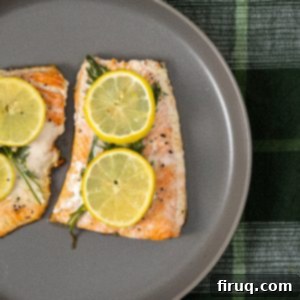
Cast Iron Lemon Dill Salmon
Vincent DelGiudiceEquipment
- cast iron pan
- instant-read thermometer
Ingredients
- ¾-1 lb wild Atlantic salmon, fresh or frozen
- 1 lemon 4 slices and one full half
- 2 tablespoon butter
- 1 clove garlic, crushed
- 1 bunch dill
- 1 tablespoon avocado oil
- salt and pepper
Instructions
- Preheat oven to 375°F (190°C).
- If using frozen salmon, thaw it out completely. Rinse thoroughly and dry aggressively with paper towels, pressing firmly on both sides to soak up excess moisture. Season both sides of the salmon with salt and pepper.
- Heat a cast iron pan over medium-high heat. Add avocado oil until shimmering. Carefully place the salmon into the pan, skin side down. Lay dill sprigs and lemon slices on top of the salmon, placing the lemon half directly on the pan. Sear for 2-3 minutes until the salmon skin is deeply golden brown and crispy.
- Add 2 tablespoons of butter and the crushed garlic clove to the pan. Baste the salmon generously with the melted butter and garlic mixture using a spoon for about 1 minute, until most of the butter is absorbed. Transfer the entire cast iron pan to the preheated oven. Cook for 3-7 more minutes, or until the salmon reaches an internal temperature of exactly 120°F (49°C) for a medium-rare finish (or 145°F/63°C for well-done). Squeeze the roasted lemon half over the fish for a burst of fresh citrus. Remove from the cast iron pan immediately to prevent overcooking.
- Serve immediately with your favorite sides, such as Jasmine rice and roasted asparagus.
Notes
- Rinse the salmon to remove any ice crystals that remain on it. Use a paper towel to apply pressure to the salmon, without pushing too hard, to remove as much liquid as possible. Do this to both sides of the fish.
- Removing excess water from frozen salmon makes the fish cook evenly and will make sure that it doesn’t get cooked by steam as that moisture heats up.
